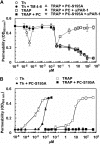The ligand occupancy of endothelial protein C receptor switches the protease-activated receptor 1-dependent signaling specificity of thrombin from a permeability-enhancing to a barrier-protective response in endothelial cells
- PMID: 17823308
- PMCID: PMC2190610
- DOI: 10.1182/blood-2007-06-096651
The ligand occupancy of endothelial protein C receptor switches the protease-activated receptor 1-dependent signaling specificity of thrombin from a permeability-enhancing to a barrier-protective response in endothelial cells
Abstract
Recent studies have indicated that activated protein C (APC) may exert its cytoprotective and anti-inflammatory activities through the endothelial protein C receptor (EPCR)-dependent cleavage of protease-activated receptor 1 (PAR-1) on vascular endothelial cells. Noting that (1) the activation of protein C on endothelial cells requires thrombin, (2) relative to APC, thrombin cleaves PAR-1 with approximately 3 to 4 orders of magnitude higher catalytic efficiency, and (3) PAR-1 is a target for the proinflammatory activity of thrombin, it is not understood how APC can elicit a protective signaling response through the cleavage of PAR-1 when thrombin is present. In this study, we demonstrate that EPCR is associated with caveolin-1 in lipid rafts of endothelial cells and that its occupancy by the gamma-carboxyglutamic acid (Gla) domain of protein C/APC leads to its dissociation from caveolin-1 and recruitment of PAR-1 to a protective signaling pathway through coupling of PAR-1 to the pertussis toxin-sensitive G(i)-protein. Thus, when EPCR is bound by protein C, the PAR-1 cleavage-dependent protective signaling responses in endothelial cells can be mediated by either thrombin or APC. These results provide a new paradigm for understanding how PAR-1 and EPCR participate in protective signaling events in endothelial cells.
Figures






Similar articles
-
Protease activated receptor 1 (PAR-1) activation by thrombin is protective in human pulmonary artery endothelial cells if endothelial protein C receptor is occupied by its natural ligand.Thromb Haemost. 2008 Jul;100(1):101-9. doi: 10.1160/TH08-02-0127. Thromb Haemost. 2008. PMID: 18612544 Free PMC article.
-
The occupancy of endothelial protein C receptor by its ligand modulates the par-1 dependent signaling specificity of coagulation proteases.IUBMB Life. 2011 Jun;63(6):390-6. doi: 10.1002/iub.447. Epub 2011 Mar 24. IUBMB Life. 2011. PMID: 21438119 Free PMC article. Review.
-
Occupancy of human EPCR by protein C induces β-arrestin-2 biased PAR1 signaling by both APC and thrombin.Blood. 2016 Oct 6;128(14):1884-1893. doi: 10.1182/blood-2016-06-720581. Epub 2016 Aug 25. Blood. 2016. PMID: 27561318 Free PMC article.
-
Receptors of the protein C activation and activated protein C signaling pathways are colocalized in lipid rafts of endothelial cells.Proc Natl Acad Sci U S A. 2007 Feb 20;104(8):2867-72. doi: 10.1073/pnas.0611493104. Epub 2007 Feb 13. Proc Natl Acad Sci U S A. 2007. PMID: 17299037 Free PMC article.
-
The protein C pathway and sepsis.Thromb Res. 2012 Mar;129(3):296-300. doi: 10.1016/j.thromres.2011.11.013. Epub 2011 Dec 7. Thromb Res. 2012. PMID: 22154246 Review.
Cited by
-
Molecular Dambusters: What Is Behind Hyperpermeability in Bradykinin-Mediated Angioedema?Clin Rev Allergy Immunol. 2021 Jun;60(3):318-347. doi: 10.1007/s12016-021-08851-8. Epub 2021 Mar 16. Clin Rev Allergy Immunol. 2021. PMID: 33725263 Free PMC article. Review.
-
Role of Thrombin in Central Nervous System Injury and Disease.Biomolecules. 2021 Apr 12;11(4):562. doi: 10.3390/biom11040562. Biomolecules. 2021. PMID: 33921354 Free PMC article. Review.
-
Targeting biased signaling by PAR1: function and molecular mechanism of parmodulins.Blood. 2023 Jun 1;141(22):2675-2684. doi: 10.1182/blood.2023019775. Blood. 2023. PMID: 36952648 Free PMC article. Review.
-
Signaling pathways and intervention therapies in sepsis.Signal Transduct Target Ther. 2021 Nov 25;6(1):407. doi: 10.1038/s41392-021-00816-9. Signal Transduct Target Ther. 2021. PMID: 34824200 Free PMC article. Review.
-
Activated protein C protects against ventilator-induced pulmonary capillary leak.Am J Physiol Lung Cell Mol Physiol. 2009 Jun;296(6):L1002-11. doi: 10.1152/ajplung.90555.2008. Epub 2009 Apr 10. Am J Physiol Lung Cell Mol Physiol. 2009. PMID: 19363121 Free PMC article.
References
-
- Esmon CT. Molecular events that control the protein C anticoagulant pathway. Thromb Haemost. 1993;70:29–35. - PubMed
-
- Stenflo J. Structure and function of protein C. Semin Thromb Hemost. 1984;10:109–121. - PubMed
-
- Walker FJ, Fay PJ. Regulation of blood coagulation by the protein C system. FASEB J. 1992;6:2561–2567. - PubMed
-
- Dahlbäck B. Protein S and C4b-binding protein: Components involved in the regulation of the protein C anticoagulant system. Thromb Haemost. 1991;66:49–61. - PubMed
Publication types
MeSH terms
Substances
Grants and funding
LinkOut - more resources
Full Text Sources
Other Literature Sources
Miscellaneous

